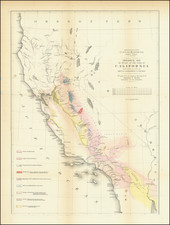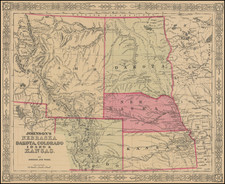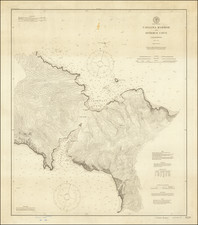One of the Earliest Maps to Show Austin. With the Addition of Four Proposed Railroads in Texas
The Rare 1840 Edition of one of the "Foundation Stones of Western Mapping History" (Wheat).
A pivotal edition of Brué's map of Mexico and the American Southwest, with substantial corrections to the Salt Lake region and numerous additions in Texas.
Brué's wall map is a tour de force for the Transmississippi West, coming on the eve of the Mexican War, the California Gold Rush, and the period of intensive American exploration in the west. Wheat described Brue's work as "monumental," much on the order of the Arrowsmith and Wyld maps of the period. As with those older maps, Brué's work underwent frequent updates. The map was first issued in 1834, and revised in 1837, 1839, 1840, 1845 and 1848, keeping abreast of the changing landscape of the region and the political intrigues of the United States, England, France, Russia, and of, course Mexico.
This edition of the map is of particular importance for its treatment of Texas, naming Austin, which was also added to Stephen F. Austin's map in 1840. The city had only been incorporated in December of 1839, and hadn't appeared on Austin's 1839 map. A few of the other changes on Brué's piece can also be traced back to that map, including the addition of Sabine and Monticello. However, other changes, notably the addition of four proposed rail lines, are not from Austin's work, showing that Brué compiled his maps to a standard above even the best regional maps.
Another fascinating addition is the appearance of "Arizona", south of the headwates of the Rio Gila, between Las Cruces and Ojo Caliente. First appearing on the 1834 edition of Brue's map, this would seem to be the earliest appearance of the name Arizona on a printed map.
The other region for which this map bears particular importance is in the Salt Lake region. The Intermountain West shows a complete reworking of its hydrography as well as a couple of additional place names. This derives almost fully from John Arrowsmith's 1832 map of Mexico by way of Hood's 1838 map of Oregon. Brué also includes a note describing a fur trading outpost on the east shore of the lake.
In California, two massive lakes are noted east of the Coastal Range on the Tulares River, with a very tentative depiction of the Sierra Nevada Mountains given.
Corrections in the Trans-Mountain West
The treatment of Alta California and the region west of the Rocky Mountains abounds with corrections from the 1839 map. These updates almost certainly stem from the Map of the United States Territory. . . 1838 published by Washington Hood in D.C. This map was itself informed, particularly in the Salt Lake and Great Basin Regions, by John Arrowsmith's 1832-published Mexico.
The updates are extensive, with the rectification of the shape of the Great Salt Lake, the addition of the Carson Sink, and the clarification of the Sacramento-San Joaquin River System. These updates mostly draw from the Hood map, and the corrections stop at approximately the 38th parallel, where Hood's corrections stop.
Hood, in turn, drew his Great Basin information from Arrowsmith, while his Sacramento information is new. Brown argues that this information must come from the Jedidiah Smith expedition, which would make Arrowsmith, and not Brue, the first to incorporate the information from that expedition. The information regarding the hydrography in the Great Basin west of the Great Salt Lake, in particular that of the Carson Sink and the Buenaventura River, is in turn purported to come from Peter Ogeden's fifth expedition of 1828-29.
While most of the updates in the Sacramento River appear to match Hood's information, particularly in the nomenclature of the upper branches of the river and a purported overland connection to the Carson Sink, there are certain differences. Particularly notable are the differences in the course of the San Joaquin River and the appearance of the River Jesus.
For an in-depth treatment of the Arrowsmith map and its influence, please refer to Brown's 2022 article John Arrowsmith's Maps of 1832: A Little-Known Breakthrough in the Cartography of Western North America.
Early Railroads in Texas
This map contains one of the earliest indications of railroads in Texas. The late 1830s and early 1840s saw waves of different plans to build railroads in the state, even if none would be operational until 1853 (the route from Houston to Stafford, approximately shown on the map). The planning appeared to start in July of 1840 when Charles L. Clark was awarded a contract to build the start of that railroad.
Despite the delays between planning and building a railroad, the Republic still rushed headlong into the idea of railroads. The City of Houston adopted a seal in 1840 showing a train, even if that development would be years away.
List of Changes from the 1839 Edition
The title of the map is changed from "Nouvelle Carte du Mexique, Et D'Une Partie Des Provinces Unies De L'Amerique Centrale." to "Nouvelle Carte du Mexique, du Texas et D'Une Partie des Etats Limitrophes.
In Texas:
- Four railroads added in Texas:
- A line between Washington and Houston
- A line between Houston and the Brazos
- A line between the Brazos and Galveston Bay
- A proposed line between the Red River and the Trinidad
- Austin appears for the first time (not on the 1840 Mitchell map, not on 1839 Austin but on 1840)
- Mina changed to "Mina ou Bastrop"
- "Chemin des Comanches" removed, but trail still present
- Town of Sabine added
- Monticello added on the Brazos
- Ft. Alamo marked
Elsewhere:
- Great Salt Lake corrected. Fur Depot marked on eastern bank, Lac Timpanogos removed
- "Youta" village added on the Colorado
- Buenaventura River added with a "Lac et Marais Teguayo."
- Configuration of the Adams River shortened
- Astely River added
- Ogden River added
- A number of coastal rivers between San Fransisco and the Oregon border
- Course of the Sacramento River traced far inland. Reference to sourcing from the Timpanogos Lake removed
- A number of minor hydrographical changes in Oregon
- Napestle River rerouted west of James Peak
- Annotations removed from the source of the Red River
Rarity
We locate four institutional examples of the 1840 edition through OCLC, at Stanford, the University of Alabama, Texas A&M, and the University of Texas, Arlington. We are also aware of examples at Harvard and the University of North Texas.
John Arrowsmith's Maps of 1832: A Little-Known Breakthrough in the Cartography of Western North America. Wesley Brown, Fall 2022.
Andre Hubert Brué was a French geographer and cartographer. Born in Paris, he served in the French Navy, joining the Baudin expedition to the Pacific (1800-1804). After his sea service, Brué applied his navigation and charting skills to creating finely-crafted maps, which were renowned for their crisp engraving and accuracy. He drew directly on the copper of the plate, creating what he called encyprotypes. He is best known for the Atlas universal de géographie physique, politique, ancienne et moderne.

![Nouvelle Carte Du Mexique, Du Texas Et D'Une Partie Des Etats Limitrophes . . . 1840 [Proposed Railroads In Texas -- First Appearance of Arizona on a Printed Map] By Adrien-Hubert Brué](https://storage.googleapis.com/raremaps/img/small/103480.jpg)








![(Mexican-Aztec Painting) [Watercolor of three Aztec deities from the Codex Vaticanus:] Toxcatl, God of Droughts and Inundations. Cod. Vat. Tlaloc. God of Water. Cod. Vat. Tecuilvitontl [Tecuilhuitontli] The Lesser Festival of the Lords. Cod. Vat.](https://storage.googleapis.com/raremaps/img/small/103009.jpg)


![Texas [Arkansas on verso]](https://storage.googleapis.com/raremaps/img/small/99448.jpg)
![[ Baja California / Gulf of California ] Carta Esferica de las Costas y Golfo De Californias Llamado Mar De Cortes Que Comprende desde el Cabo Corrientes hasta el Puerto de San Diego Construida …. 1825](https://storage.googleapis.com/raremaps/img/small/102732.jpg)
